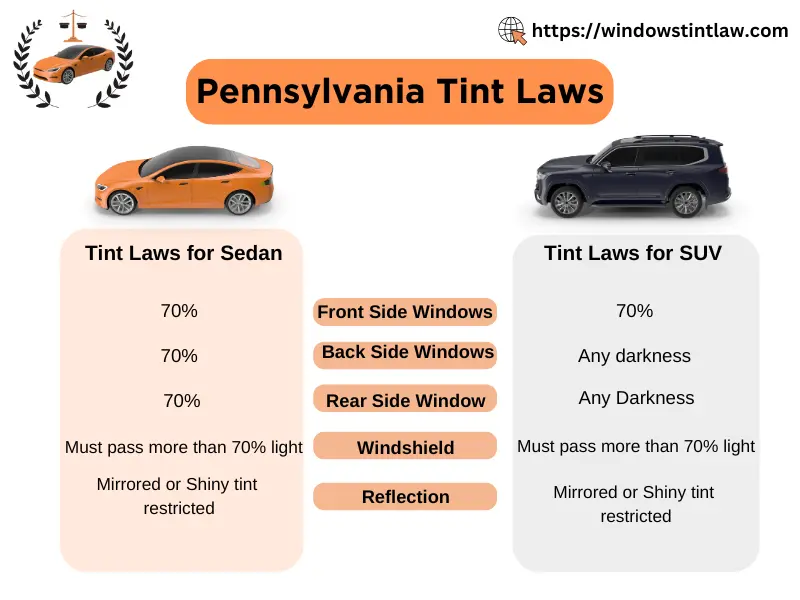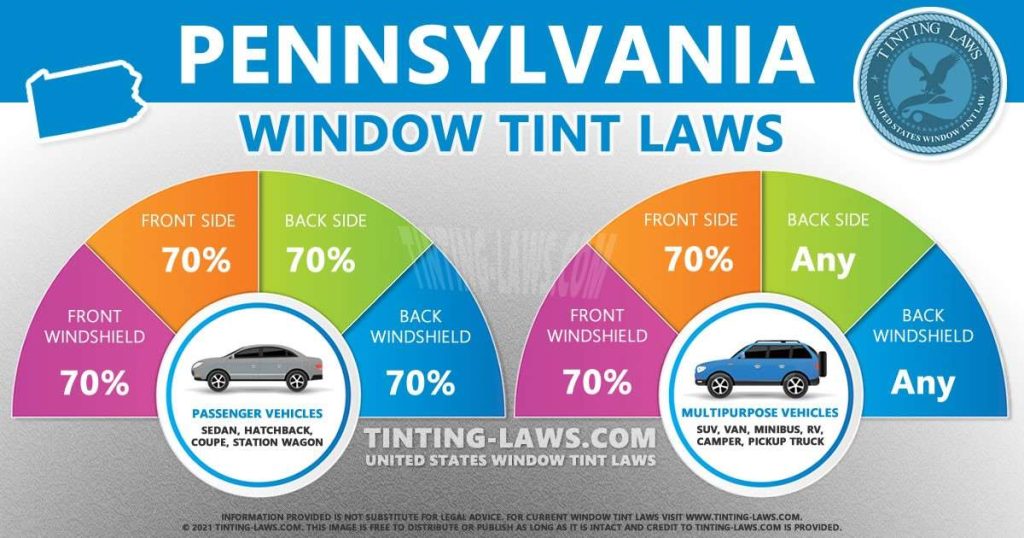When you’re cruising through the scenic roads of Pennsylvania, the sun can be both a friend and a foe. It lights up your path but can also turn your car into a sweltering oven.
That’s why many drivers consider window tinting a must-have. But before you make any changes, you need to know the ins and outs of Pennsylvania’s tint law. Imagine the peace of mind that comes with knowing your vehicle is in full compliance.
You don’t want any unexpected tickets or fines, right? Understanding these regulations not only keeps you on the right side of the law but also helps you enjoy a smoother, more comfortable drive. So, let’s dive into what you need to know about Pennsylvania’s tint law and ensure your ride is as cool as it looks. Ready to avoid those roadblocks? Keep reading!

Credit: windowstintlaw.com
Tint Law Basics
Pennsylvania’s tint law can seem complex at first. Understanding the basics is key. Tinting your car windows offers privacy and comfort. Yet, knowing the legal limits is crucial to avoid penalties.
Legal Tint Limits
The tint limits differ for various vehicles. Passenger cars have stricter rules compared to SUVs and vans. Front side windows must allow more than 70% light. Rear windows and back side windows can be darker. Windshields should only have a non-reflective tint on top.
Types Of Vehicle Windows
Different windows have different rules. Front side windows must be lighter for safety reasons. Rear windows can have darker tints, offering more privacy. Back side windows follow similar rules to rear windows. Windshields have specific guidelines to ensure driver visibility.
Penalties For Violations
Violating Pennsylvania tint laws can lead to fines and vehicle inspections. Excessively dark tints may result in penalties and mandatory removal. Complying with state regulations is essential to avoid legal issues and ensure safe driving visibility.
Understanding the penalties for violating Pennsylvania’s tint law is crucial if you want to avoid unnecessary headaches and expenses. Many drivers often overlook how strict these laws can be until they face the consequences firsthand. Let’s break down what you need to know about these penalties, and how they can affect your driving experience.Fines And Fees
If you’re caught with illegally tinted windows in Pennsylvania, brace yourself for some fines. The state imposes a standard fine that can reach up to $110 per violation. This might not sound like much initially, but these fines can quickly add up, especially if you’re a repeat offender. On top of the fine, you might also be required to pay court fees. These additional costs can make a seemingly minor infraction turn into a significant financial burden. It’s worth considering whether the look or privacy of tinted windows is worth the potential hit to your wallet.Impact On Vehicle Inspections
Illegal tint can also impact your vehicle’s inspection process. Pennsylvania requires vehicles to pass annual inspections to ensure they’re roadworthy. Tinted windows that don’t comply with the law can lead to a failed inspection. A failed inspection means you’ll have to remove the tint and go through the inspection process again, costing you both time and money. This can be particularly frustrating if you need your vehicle for daily commutes or work. Have you ever had to rearrange your schedule because your car wasn’t ready? It’s a hassle you can avoid by ensuring your tint is legal. Ensuring compliance with tint laws might seem like a small detail, but it can save you from unexpected penalties and disruptions. Are those darker windows worth the risk of fines and failed inspections? Consider the impact on your finances and day-to-day convenience before making a decision.Exceptions And Exemptions
Pennsylvania tint law offers specific exceptions and exemptions for certain vehicles. Medical conditions may allow darker tints with proper documentation. Antique vehicles and official cars often have different requirements, ensuring compliance with state regulations.
When discussing Pennsylvania Tint Law, it’s important to recognize that there are certain exceptions and exemptions. These are designed to accommodate specific needs and situations. Understanding these can help you navigate the regulations more effectively, ensuring that your vehicle meets the legal requirements while addressing unique circumstances. ###Medical Waivers
In Pennsylvania, individuals with certain medical conditions can apply for a tint exemption. This waiver allows for a darker tint than typically permitted by law. It’s a practical solution for those who are sensitive to sunlight or have skin conditions that require additional protection from UV rays. To obtain a medical waiver, you need documentation from a licensed physician. This paperwork should clearly state the medical necessity for a darker tint. Once approved, the waiver must be kept in the vehicle at all times. Have you ever considered how a simple document can make your drive more comfortable? For those with valid medical reasons, this waiver is a game-changer, offering both comfort and protection. ###Special Vehicles
Certain vehicles are granted exemptions under Pennsylvania Tint Law due to their unique purposes. Police cars, for example, often have darker tints for security and operational reasons. Similarly, vehicles used for transporting valuable goods might require additional privacy. If you own a vehicle that falls into this special category, it’s crucial to ensure it’s properly documented. This not only keeps you compliant with the law but also helps avoid unnecessary fines or legal issues. Do you drive a vehicle for special purposes? Understanding how these exemptions apply can save you from potential hassles. Always keep the necessary paperwork handy, and know your rights and obligations. By knowing the exceptions and exemptions within Pennsylvania’s tint law, you can make informed decisions about your vehicle. Whether due to medical needs or special vehicle use, these provisions help ensure that the law accommodates diverse needs without compromising safety.
Credit: thetintlaws.com
Tips For Compliance
Understanding Pennsylvania’s tint law is crucial for maintaining your car’s compliance and ensuring a hassle-free driving experience. While tinting can add style and privacy to your vehicle, it’s essential to adhere to legal standards to avoid fines and penalties. Here are some practical tips to help you comply with the regulations.
Choosing The Right Tint
The first step in compliance is choosing the right tint for your vehicle. Pennsylvania law specifies different tint percentages for various windows.
Front side windows must allow more than 70% of light in. This means you should avoid dark tints that compromise visibility.
When selecting a tint, consider your driving habits. Do you drive mostly at night or during the day? A lighter tint might be better for night driving.
It’s also important to think about the aesthetic appeal. Choose a shade that complements your vehicle’s color while adhering to legal guidelines.
Remember, the goal is to balance style with legal compliance. Avoid overly dark tints that could lead to fines.
Professional Installation
Having your tint installed by a professional can be a game-changer. They ensure the tint is applied evenly and legally.
Professionals are well-versed in the law and can guide you on the best tint options. They have the tools to measure light transmission accurately.
Professional installation reduces the risk of bubbles and peeling, which can happen with DIY jobs. This ensures your vehicle looks sleek and remains compliant.
You might think it’s expensive, but consider the potential fines for non-compliance. A professional job is an investment in peace of mind.
Ask yourself, is it worth the risk to go DIY? Many find that the expert touch is invaluable.
By choosing the right tint and professional installation, you ensure your vehicle remains stylish and within the boundaries of Pennsylvania law. Compliance isn’t just about avoiding penalties; it’s about making informed choices that suit your lifestyle.
Updating And Monitoring Laws
Understanding Pennsylvania’s tint law is essential for car owners. These laws can change, affecting compliance. Regularly updating and monitoring these laws ensures you avoid penalties. Staying informed helps you maintain legal tint levels on your vehicle. Let’s explore how to keep up with these changes.
Staying Informed
Stay informed about tint laws by checking trusted sources. Pennsylvania’s Department of Transportation (PennDOT) provides updates. Local news outlets often report changes too. Subscribing to newsletters from automotive websites helps keep you in the loop. Regularly checking these sources ensures you’re aware of any law changes.
Resources For Updates
Use online resources for the latest tint law updates. PennDOT’s official website offers reliable information. Legal websites also provide updates on state regulations. Forums dedicated to car enthusiasts can be helpful too. Engaging with these platforms keeps you informed and compliant.

Credit: www.tinting-laws.com
Frequently Asked Questions
Is A 20% Tint Legal In Pa?
A 20% tint is not legal in Pennsylvania for the front windows. The legal limit for front side windows is 70% light transmission. Ensure compliance to avoid fines. Always check local regulations for the most accurate and updated information.
What Is The Darkest Legal Tint In Pa?
In Pennsylvania, the darkest legal tint for vehicle windows is 70% light transmission for the front windshield. Side windows and rear windows can be tinted to any darkness level. Ensure compliance with state regulations to avoid penalties.
Is 35% Tint Legal In Pa Reddit?
In Pennsylvania, 35% window tint is legal for rear and back side windows. Front side windows require at least 70% visibility. Always check for updates on local laws to ensure compliance.
Is 20% Or 35% Tint Darker?
20% tint is darker than 35% tint. Tint percentage indicates the amount of light passing through. Lower percentage means less light and more darkness.
Conclusion
Navigating Pennsylvania’s tint law is crucial. It helps avoid penalties. Know your vehicle’s tint limits. This ensures compliance and safety. Remember, different rules apply to cars and trucks. Legal tint varies by window type. Properly tinted windows enhance driving comfort.
They protect against sun glare. Following the law is not just smart. It’s essential for road safety. Understanding these rules keeps you informed. It also avoids fines or legal issues. Respect the state’s regulations. Drive safely with legal tint. Stay aware, stay compliant.
